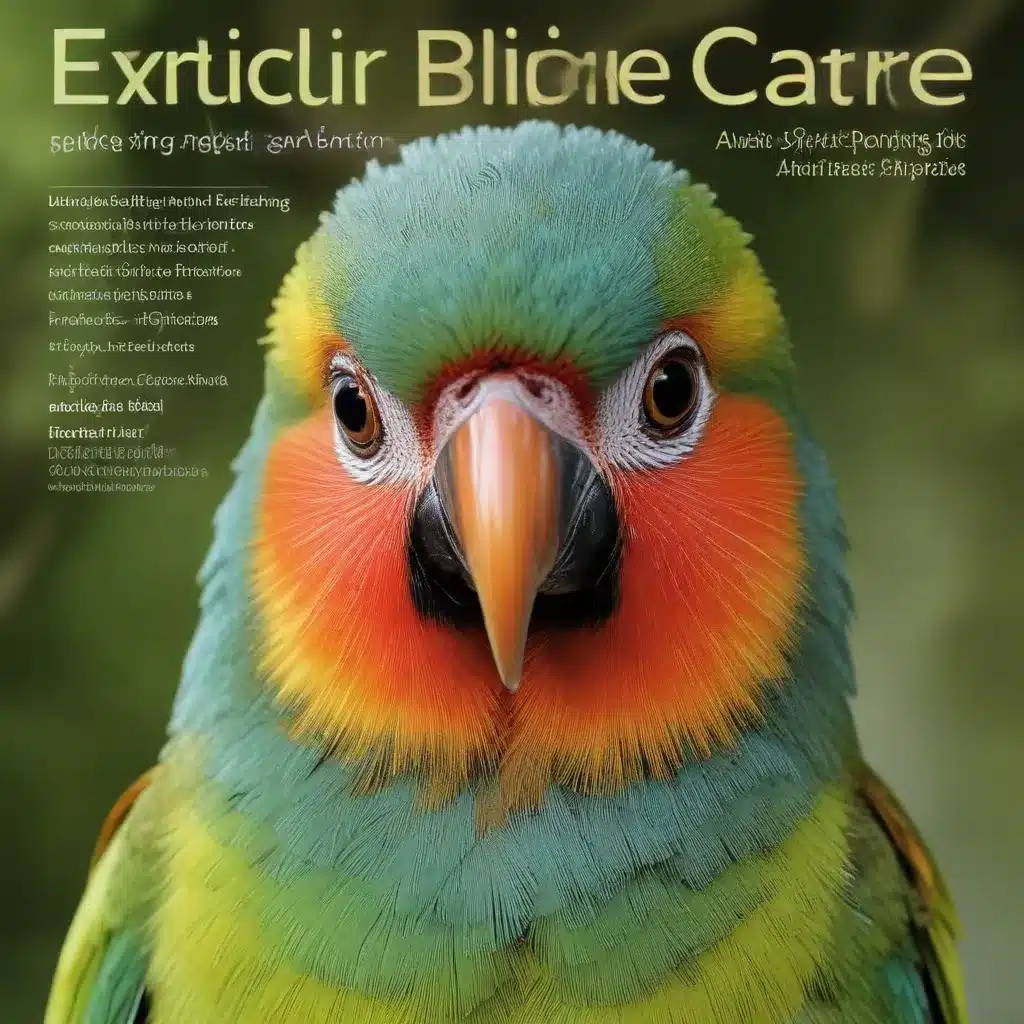
As an experienced avian caretaker and expert in the field, I’ve had the privilege of working with a diverse array of exotic bird species. From the vibrant plumage of parrots to the captivating displays of cockatoos and macaws, these feathered companions have captured the hearts of many. However, the path to successful avian breeding and reproduction is often shrouded in mystery, requiring a deep understanding of the intricate biology and behavioral nuances of these remarkable creatures.
Avian Taxonomy: Exploring the Diversity of Exotic Bird Species
The parrot family, or Psittacidae, is a diverse and captivating group of birds that includes parrots, cockatoos, and macaws. These species are known for their vibrant colors, intelligent personalities, and strong social bonds. Cockatoos, with their distinctive crests and playful demeanors, are a particular favorite among avian enthusiasts. Macaws, on the other hand, are renowned for their impressive size, striking plumage, and impressive vocalizations.
Understanding the unique characteristics and requirements of these exotic bird species is crucial for providing them with the optimal care and environment to thrive, both in captivity and in their natural habitats.
Avian Habitat and Ecology: Adapting to the Wild
To effectively breed and care for exotic birds, it’s essential to have a deep appreciation for their native environments and ecological adaptations. Parrots, cockatoos, and macaws are predominantly found in tropical and subtropical regions, where they have evolved to thrive in diverse ecosystems, from lush rainforests to arid savannas.
These birds have developed intricate behavioral patterns and dietary preferences to suit their natural habitats. For instance, many parrot species rely on a varied diet of seeds, nuts, fruits, and even the occasional insect or small vertebrate. Cockatoos, on the other hand, are known for their fondness for nectar and pollen-rich flowers, while macaws often specialize in cracking open hard-shelled nuts and seeds.
By understanding the specific habitat requirements and ecological adaptations of these exotic birds, we can create captive environments that closely mimic their natural conditions, providing them with the necessary resources and stimuli to engage in natural behaviors and thrive.
Avian Reproduction: Unlocking the Mysteries of Breeding Success
At the heart of successful avian breeding lies a deep understanding of the intricate reproductive behaviors and physiological processes that govern these fascinating creatures. Courtship rituals, nest construction, egg-laying, incubation, and chick rearing are all integral components of the avian breeding cycle.
Courtship behaviors among exotic birds can be truly captivating, with species-specific displays and vocalizations used to attract mates and establish pair bonds. The construction of nests, often in the form of hollows, cavities, or intricate structures, provides a secure and suitable environment for the birds to lay and incubate their eggs.
The incubation period and subsequent chick development are critical stages in the breeding process, requiring meticulous attention to temperature, humidity, and parental care. Ensuring that the chicks receive the proper nutrition, socialization, and environment during this delicate phase is essential for their healthy growth and successful fledging.
Avian Health and Wellness: Nurturing Optimal Conditions
Maintaining the health and wellness of exotic birds is a multifaceted challenge that encompasses various aspects of their care, from nutrition to veterinary support.
A balanced and species-appropriate diet is crucial for supporting the overall well-being of these birds. Providing a variety of high-quality seeds, pellets, fruits, and vegetables, along with essential vitamin and mineral supplements, can help ensure that their nutritional needs are met. Proper hydration is also a key factor in maintaining avian health.
Regular veterinary check-ups and preventative care are essential for identifying and addressing any potential health issues before they escalate. Common avian illnesses, such as viral infections, bacterial infections, and nutritional deficiencies, require prompt diagnosis and effective treatment protocols to ensure the well-being of the birds.
In the event of illness or injury, rehabilitation strategies, including specialized diets, medication, and physical therapy, can play a vital role in the recovery and reintegration of these birds into their captive or natural environments.
Avian Husbandry: Creating Optimal Environments for Breeding Success
Designing and maintaining appropriate enclosures for exotic birds is a crucial aspect of successful avian breeding and care. Providing adequate cage sizes, diverse perch options, and enrichment opportunities can help mimic the natural habitats of these species and encourage natural behaviors, such as foraging, climbing, and social interactions.
Socialization and training techniques can also play a significant role in the well-being of captive-bred birds. By fostering positive human-bird interactions and exposing them to various stimuli, we can help reduce stress, enhance their overall quality of life, and potentially improve their breeding success.
Quarantine protocols and disease prevention measures are also essential for maintaining the health and safety of both the birds and their human caretakers. Proper hygiene, biosecurity practices, and strict quarantine procedures can help mitigate the risks of disease transmission and ensure the long-term well-being of the avian population.
Conclusion: Embracing the Wonders of Avian Breeding and Reproduction
Unlocking the secrets to successful avian breeding and reproduction is a multifaceted endeavor that requires a deep understanding of exotic bird species, their natural habitats, and the intricate processes that govern their reproductive cycles. By combining our knowledge of avian taxonomy, ecology, health, and husbandry, we can create optimal conditions for these remarkable creatures to thrive, both in captivity and in the wild.
As avian caretakers and enthusiasts, our responsibility extends beyond simply providing for the basic needs of these birds. It is our duty to continuously expand our knowledge, adapt our practices, and advocate for the conservation of these species and their habitats. Through our collective efforts, we can ensure that the wonders of avian breeding and reproduction are preserved for generations to come, inspiring awe and wonder in all who have the privilege of encountering these feathered marvels.
If you’re interested in learning more about exotic bird care and breeding, I encourage you to visit the Mika Birds Farm website, where you’ll find a wealth of resources and expert guidance to help you on your avian journey.


